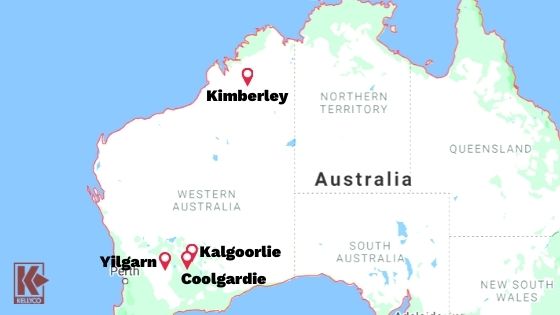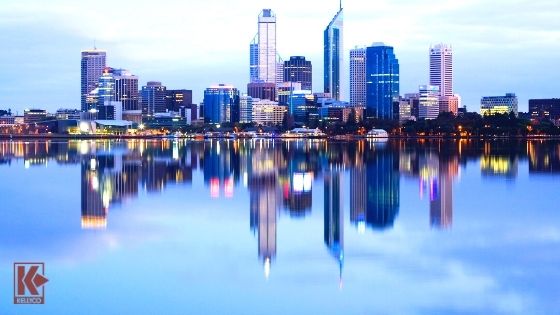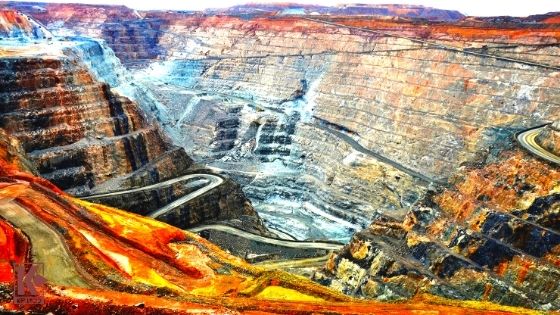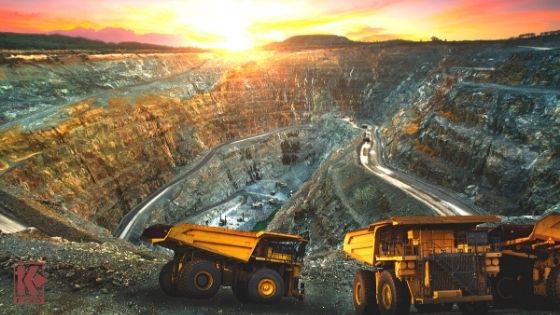The Western Australia Gold Rushes
Published by Sam Jacobs on 12/11/20
Western Australia was the home of multiple gold rushes between 1885 and 1893. And the region continues to produce copious amounts of gold to this day. Gold mining is the third-largest commodity sector in the region today, after iron ore and petroleum, generating nearly A $12 billion worth of value every year.

Western Australia
Indeed, there wasn’t much reason to live in Western Australia before the discovery of gold in the region. Before the first Western Australian Gold Rush, the primary industries in the area were wool, wheat, and meat. The discovery of gold dramatically changed the history of the region and, indeed, the entire country with tens of thousands of gold prospectors streaming into the region in search of the mother lode.
But it all began, as is often the case, with a single strike of gold. This first strike in the case of Western Australia Gold Rushes was made by Charles Hall and Jack Slattery and set off what is known as the Kimberley Gold Rush.
The First Western Australia Gold Rush: Kimberley Gold Rush
Before the first real gold strike in the Kimberley region of Western Australia, there was some inkling that underneath the ground there lurked vast riches. Alexander Forrest made an expedition into the area in 1879. He reported similarities between the rocks there and the rocks in other regions where there was gold. This prompted Adam Johns and Phil Saunders to make a trek in search of gold in April 1882, where they were able to find trace amounts of gold in the headwaters of the Ord River. They reported their findings to the Colonial Secretary, as well as their belief that there were substantial amounts of gold ready for the taking.
This was how Charles Hall found himself in Western Australia. He was in search of not just gold, but the £5,000 reward being offered by the colonial government for the first man to strike a paying gold claim in the region. It was Hall who first discovered alluvial gold (which is gold deposited by the movement of water) in the Kimberley Region, the northernmost of the nine regions of Western Australia, near a town that is now named after him. He made his finds with his partner Jack Slattery on Christmas Day in 1885, making it perhaps the best Christmas since the original. The nugget was 28 ounces or nearly a full kilogram of gold.
Further deposits of alluvial gold were found in Marble Bar, Southern Cross, and Yalgoo, each of which helped the population of Western Australia to explode in a few short months. All told, 15,000 people flooded into what is known today as Old Halls Creek. However, the land was tough and unforgiving and many of the new settlers died there. Anyone wishing to pay their respects to those who blazed the first trails into the region can visit their graves in a small cemetery in what is now known as the Old Town region of Halls Creek.
The Kimberley Gold Rush was a very short-lived affair. All told, it lasted three months before people realized that the land was harsh and that the gold was difficult to get out of the ground. The region was never prosperous and very few men were able to get any significant amounts of gold out of this first of the Western Australia Gold Rushes.
The original claim itself failed to collect on the reward offered by the colonial government because it did not produce the 10,000 ounces of gold required. What’s more, the government levied a tax of two shillings and sixpence an ounce, which disincentivized the search for the already hard-to-find gold. Most prospectors did anything they could to avoid paying the tax and thus the records of how much gold was discovered are unreliable at best. Modern historians believe that 23,000 ounces of gold were extracted from the region, but very little of it was reported and thus taxed.
By this time, there were a scant 2,000 men left in the region. In short, there was a lot of hard work that the people who were dreaming of a quick and easy ticket to riches weren’t prepared for. The area transitioned into a trading center dominated by cattle stations and the miners who remained behind as the region emptied. Today the region is one of the largest predominantly aboriginal communities in Australia.
The Second Western Australia Gold Rush: Yilgarn Gold Rush

Expedition to Bindoon, Australia
The second of the Western Australia Gold Rushes began outside of the town of Southern Cross in 1887. The first strike was made by Harry Anstey, a metallurgist, and prospector. It was this discovery that led to the establishment of the Eastern Gold Fields that are still in operation in Western Australia today.
Anstey was the consummate Englishman, having received his education at Rugby and resided in the posh Kensington area of London where he worked as a civil engineer before he set sail for Western Australia in 1887. He set up his metallurgical laboratory in Perth, a city that remains the center of gold production in the Commonwealth of Australia to this day.
Soon after his arrival, he was invited by prospectors Richard Greaves and Edward Payne to join them on an expedition to Bindoon, Western Australia. It was in Yilgarn that a station owner reported his find of a golden nugget while dropping a well. Anstey commanded an expedition in the region representing himself and his partners. The party discovered a reef, which kicked off the second of the Western Australia Gold Rushes. They were backed by George Leake, who at the time was the Solicitor-General of Western Australia, but later became the Premier.
Beyond the simple monetary gain of having found a large amount of gold, there were other perks for Anstey. When he returned to Perth in 1889, he was appointed the Government Assayer. He was later a member of the Western Australian Legislative Council. However, by 1898, he had hit the financial skids and sold everything he owned to move to Cardup, where he ran an orchard. In 1899, he returned to England.
News of the strike spread throughout the surrounding area and by late 1887, the Yilgarn Gold Rush had begun in earnest. This only intensified with the discovery of gold in the Golden Valley (named for Golden Wattle growing there, not for the gold in the area), with other strikes coming soon after.
The second of the Western Australia Gold Rushes wound down in September 1892 with the discovery of gold in Coolgardie. However, it was the Yilgarn Gold Rush that is credited with exploding the population of Western Australia from 49,782 in 1891 to 184,124 by 1901.
The Third Western Australia Gold Rush: The Coolgardie Gold Rush
At the time gold was discovered in the Coolgardie region of Western Australia, the area was known as Fly Flat. Arthur Wesley Bayley and William Ford changed all of that when they found 554 ounces (15.7 kilograms) of gold in a single afternoon using nothing more than a Tomahawk. On September 17, 1892, they rode all this gold to Southern Cross where they attempted to claim their reward from the colonial government for their new gold strike.
The new gold rush began within hours. Bayley was granted a five-acre claim that went 100 feet deep. Less than one year later, the formerly barren area had over 4,000 residents with many more outside of the newly incorporated town in the fields looking for their fortune in gold. This kicked off what is known as the greatest Gold Rush in Australian history and is often erroneously referred to as the greatest population shift in Australian history. The greatest population shift in Australian history, however, was during the gold rushes in the eastern portion of the Commonwealth.
Still, this Gold Rush left a massive mark on the history of Australia. In 1891, the population of Western Australia was 46,290. By 1901, it had risen to 184,124.
Today this first mine is known as the Bayley’s Reward mine and it remains one of the most profitable mines in the state of Western Australia.
The Final Western Australia Gold Rush: The Kalgoorlie Gold Rush

The Kalgoorlie Gold Rush
The Kalgoorlie Gold Rush was the last in the line of the Western Australia Gold Rushes. The region where gold was found here was a mere 25 miles from Coolgardie, which offered a ready supply of men and materials to toil away in the search for gold.
On June 17, 1893, Paddy Hannan found alluvial gold near Mount Charlotte. The area he discovered gold in is now called the Golden Mile, continuing to provide a lucrative stream of gold for Western Australia. It is a massive open mine known today as the Super Pit.
As his nickname might imply, Paddy Hannan was from Ireland — Sixmilebridge, County Clare, to be exact. His partners likewise hailed from the Emerald Isle, with Thomas Flanagan coming from Ennis, County Clare, and Daniel Shea getting his start in County Cork. Most of Hannan’s family had emigrated to Australia in 1852 and they maintained the same close family ties they had in the mother country on the new and forbidding lands in Australia.
Hannan arrived in Melbourne on December 23, 1862. His occupation on the ship’s manifest was listed as “laborer.”
There are several versions of the story of Hannan’s first gold strike. One holds that on the night of June 14, 1893, Hannan struck gold in a gully. However, he didn’t want to kick off a gold rush, so he concealed the claim. They concocted a tale of a missing horse and spent the next night digging for gold and marking off the area of their claim. Another version says that he concealed the find in brushwood to keep anyone from seeing it.
The law, however, demanded that anyone report their findings to the colonial authorities within seven days. The team registered their findings with the colonial government on June 17, 1893. Hannan alone registered the claim, with some speculating that this was because he was the only literate member of the team however, this was not true as Flanagan had filled out a death certificate for his brother a few years prior.
One theory as to why Hannan was the one to register the claim is because the others were simply better at digging for gold than he was. Flanagan and Shea were able to uncover an additional 100 ounces while Hannan was away filling out the proper paperwork. Another suggested reason is that he was younger and in better shape, though the real answer is probably because he was recognized as the leader of the trio.
Within three days 400 men were prospecting for gold in the area. Within a week, 1,000. Hannan and company received a six-acre mining lease on one of the richest gold veins in the world.
At age 64, in 1904, Hannan was awarded a £150 pension by the Government of Western Australia. He did not cease his prospecting efforts until he was 70 years old. He died near Melbourne under the care of two of his nieces and was interred in the Catholic section of Melbourne Central Cemetery. He is regarded as the father of Kalgoorlie. A statue was erected to him there in 1929.
The Legacy of the Western Australia Gold Rushes

Western Australia Legacy
Not so long in the young nation’s past, these four gold rushes have left a massive impact on the makeup of the country. Indeed, Perth is still a center of vast wealth to this day due to the gold rushes that took place not far from there. It ushered in what was effectively the Wild West period of Australian history, as well as the removal of the aboriginal inhabitants of the region.
In some ways, it is very much like the gold rushes that built both the mainland United States, Canada, and Alaska. It also bears a great resemblance to the gold rushes currently underway in Africa.
